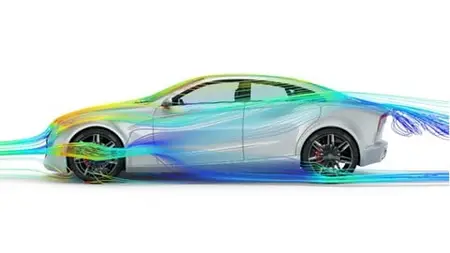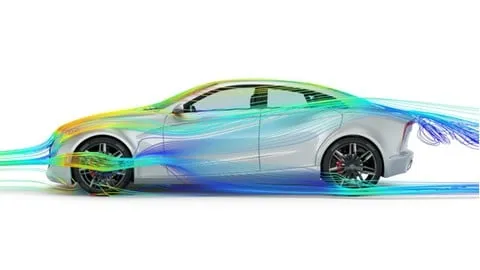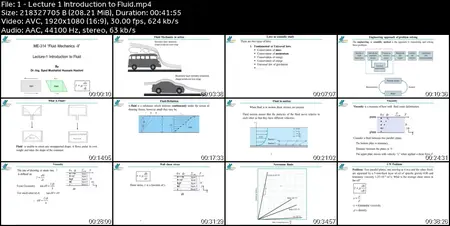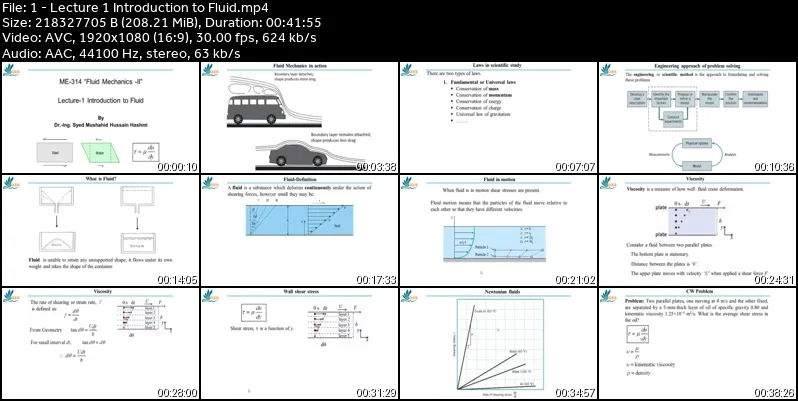Advanced Fluid Mechanics & Computational Fluid Dynamics
2024-11-29
MP4 | Video: h264, 1920x1080 | Audio: AAC, 44.1 KHz
Language: English (US) | Size: 7.43 GB | Duration: 29h 4m
2024-11-29
MP4 | Video: h264, 1920x1080 | Audio: AAC, 44.1 KHz
Language: English (US) | Size: 7.43 GB | Duration: 29h 4m
Dive deep into Fluid Mechanics with over 29 hours of advanced engineering insights and hands-on CFD applications.
What you'll learn
Provide an introductory overview of Fluid Mechanics tailored to beginner learners, covering fundamental principles and engaging course content.
Present a comprehensive derivation and detailed explanation of the continuity equation, accompanied by illustrative examples and numerical problem-solving.
Gain a thorough understanding of the momentum equation, both in its general form and in its differential form, along with practical applications.
Explore the Navier-Stokes Equation, comprehending its significance and wide-ranging applications in fluid dynamics.
Acquire a comprehensive understanding of the Reynolds Transport Theorem, including its derivation and practical implications.
Develop a solid grasp of linear and angular momentum equations and their relevance in fluid mechanics.
Dive into a detailed examination of the kinematics of various flow types, encompassing a comprehensive exploration of their characteristics.
Explore the principles of Potential Flow and delve into the concept of superposition, including in-depth discussions of its three types.
Gain insights into Turbo Machines, including the application of Euler's Equation, analysis of blade angles, and evaluating performance factors.
Obtain in-depth information about turbines, including their operational characteristics and performance evaluation.
Familiarize yourself with the core concepts of Boundary Layer, including order analysis over flat plates, turbulent flow over flat plates, the Blasius solution.
Develop an understanding of External Flow concepts, focusing on topics such as Drag Coefficient and its significance in vehicle aerodynamics.
Explore the fundamental principles of Airfoil and delve into an analysis of its performance characteristics.
Gain a comprehensive understanding of advanced concepts in Computational Fluid Dynamics (CFD), including its applications across various industries and fields.
Requirements
Basic knowledge of physics and chemistry, including an understanding of fundamental concepts related to forces, motion, energy, and basic chemical principles.
Proficiency in mathematics, particularly in calculus, differential equations, and algebra, to effectively solve equations and perform mathematical analyses in fluid mechanics.
Description
Dive deep into the intricate world of Fluid Mechanics and experience the awe-inspiring symphony of fluidic behavior that powers our natural and engineered systems. From the foundational concepts of Newton's laws applied to fluids to the complex calculations needed for engineering problem-solving, this course offers a comprehensive understanding of fluid motion and its critical role in both natural phenomena and man-made inventions. Grasp the nuances of continuity equations, momentum conservation, and the beauty of Navier-Stokes' equations, as they govern fluid flow.Embark on a journey through the intricacies of turbomachines, exploring their classifications, working principles, and applications. Delve into the dynamics of boundary layers, from their genesis to their effect on the bodies in flow. Engage in the fascinating realm of external flow, uncovering the principles behind drag, lift, and the magnificent designs of airfoils. Finally, stands at the forefront of technological advancement with an introduction to Computational Fluid Dynamics (CFD), exploring the realm of numerical simulations that push the boundaries of engineering capabilities.This course isn't just about learning theories but bridging the chasm between theory and real-world application. By the end, you will not only understand the mathematics behind fluid motion but will gain a profound appreciation for its relevance in shaping the world around us. Whether you aspire to design advanced aerostructures, engineer efficient transportation systems, or merely satiate an academic curiosity, this course is a key milestone in your journey of discovery and innovation.Reference books for this course:Fluid Mechanics by Yunus A. Cengel, John M. CimbalaFundamentals of Fluid Mechanics, 6th Edition By MunsonCOURSE OUTLINELecture-1 Introduction to FluidThe subject of Fluid MechanicsLaws in the scientific studyEngineering approach of problem-solvingFluid definitionNewton’s law of viscosityNewtonian and Non-Newtonian fluidProblems based on Newton’s law of ViscosityLecture-2 Continuity EquationPrinciple of conservation of massDifferential and Integral approachEulerian and LaGrange's approachInventory EquationDerivation of Continuity equation-Differential approachConservation and Non-Conservation Forms of ContinuityMaterial derivativeScalar and Vector fieldAcceleration fieldLecture-3 Momentum EquationNewton’s Second Law of MotionBody forceSurface forceMomentum Equation in differential formStokes postulateNavier-Stokes EquationLecture-4 Application of Navier Stokes equationN-S equation as governing equation of fluid flowApplication of the N-S equation for a steady and laminar fluid flow between two fixed infinitely long plates.Velocity profileVolume flow rate calculation from the velocity profileLocal velocity, average velocity, maximum velocityCalculating Reynolds Number from the Velocity profileLecture-5 Application of Navier Stokes equation - Couette flowThe physical meaning of the N-S equationFully developed flowApplication of N-S equation for a steady and laminar fluid flow between one fixed and one moving plate-Couette FlowApplications of Couette flowLecture-6 Reynolds Transport Theorem DerivationControl Mass (A System) and Control VolumeLagrangian and Eulerian ApproachExtensive and Intensive propertyDerivation of Reynolds Transport Theorem (RTT)Interpretation of net flux term of RTTLecture-7 Reynolds Transport Theorem - Continuity EquationReynolds Transport Theorem (RTT)Deriving Continuity Equation using RTTMass flow rate, volume flow rate, and Average speedDifferential and Integral Form of Continuity EquationLecture-8 RTT-Continuity Equation NumericalsContinuity Equation in Integral FormSolving numerical problems using Continuity EquationLecture-9 RTT- Linear Momentum EquationReynolds Transport Theorem (RTT)Deriving Momentum Equation using RTTResultant Forces acting on a CVMomentum accumulation in a CVMomentum flow through a CVLecture-10 RTT- Angular Momentum EquationReynolds Transport Theorem (RTT)Deriving Angular Momentum Equation using RTTProblem-based on Linear and Angular MomentumRTT for Moving and Deforming CVLecture-11 Kinematics of Flow-Flow TypesFluid Flow Visualization- ClassicsStreamlinePath-lineStreak-lineTimelineSoftware for flow visualization (2dflowvis)Lecture-12 Kinematics of Flow- Irrotational FlowThe motion of fluid ElementTransformation of a fluid elementAngular velocity vectorVorticity VectorIrrotational flow fieldLecture-13 Kinematics of Flow- Stream functionVisualizing velocity field-Java AppletVisualizing velocity field- MapleStream functionChange in the value of the stream functionProblem with the stream functionStream function in polar coordinatesLecture-14 Kinematics of Flow- CirculationCirculationRelationship between Circulation and VorticityStoke’s theoremProblem on CirculationThe physical meaning of Divergence of a vectorCirculation and Divergence in Java AppletLecture-15 Potential Flow- Velocity potential functionVelocity Potential function, φPotential flowRelationship between ψ and φFlow netVelocity potential function in cylindrical coordinatesVelocity Potential function in Java AppletLecture-16 Potential Flow- Basic potential flowsUniform flowSource and Sink flowVortex flowStream function and Velocity potential function for basic flowsLecture-17 Potential Flow- Superposition of potential flows-ISuperposition of basic potential flowsDoubletHalf bodyLecture-18 Potential Flow- Superposition of Potential flow-IIFlow around a cylinderFlow around a cylinder-Velocity and pressure distributionFlow around a cylinder-Drag and LiftRankine bodyProblem with Rankine BodyLecture-19 Potential Flow- Superposition of Potential flow-IIISuperposition of basic potential flowsFlow around a cylinder with circulationMagnus EffectProblem- Flow around a cylinder with circulationLecture-20 Turbo-machine- Fluid MachinesFluid machines classificationPositive Displacement machinesTurbo-machinesComparison of PDPs and Roto-dynamic pumpsTurbo-machine ClassificationsScope of Turbo-machinesLecture-21 Turbo-machine- Euler’s EquationOne-dimensional flow through an impellerVelocity triangleEuler’s equation of turbo-machineLecture-22 Turbo-machine- Blade AnglesVelocity triangleVelocity triangle at inlet-assumptionsEffect of blade angle on the headTypical Characteristic curve of a centrifugal pumpEffect of blade angle on Characteristic curveLecture-23 Turbo-machine- Performance-IProblem-Centrifugal blowerStatic, Friction, and System headPump LossesPump EfficiencyPump Performance Characteristic curvesLecture-24 Turbo-machine- Performance-IIPump System CurvePumps in Series and ParallelPump Affinity lawsPump specific speedLecture-25 Turbo-machine- TurbineTurbineSchematics of hydraulic turbinesVelocity triangles of TurbineImpulse TurbineReaction TurbineDegree of ReactionLecture-26 Turbo-machine- Turbine PerformancePump and Turbine EfficienciesGeneral Energy EquationProblem-TurbineAffinity laws for TurbineTurbine specific speedLecture-27 Boundary layer- ConceptClassification of flowsOne-dimensional and multi-dimensional flowSteady and Unsteady flowUniform and Non-Uniform flowInviscid and Viscous flowAttached and Flow SeparationLaminar and Turbulent flowPrandtl-Boundary layer conceptGrowth of boundary layer thicknessLecture-28 Boundary Layer- Order Analysis over Flat PlateOrder of Magnitude or Scale AnalysisOrder of Magnitude Analysis over a flat plateBoundary layer thickness as a function of Reynold’s NumberWall shear stress using Scale AnalysisSkin friction coefficient using Scale AnalysisLecture-29 Boundary layer- Blasius solutionLaminar boundary layer on a flat plateBlasius solutionWall shear stress using Blasius solutionFriction coefficient using Blasius solutionProblem- Using Blasius's solutionLecture-30 Boundary layer- turbulent flow over a flat plateTurbulent flowGoverning Equations in Turbulent FlowBoundary layer in turbulent flowThe velocity profile in laminar and turbulent flowVelocity distribution in the turbulent boundary layerLaw of wallLecture-31 Boundary layer- Displacement and Momentum thicknessDisturbance or Boundary layer thicknessDisplacement thicknessDisplacement thickness using Blasius solutionMomentum thicknessMomentum thickness using Blasius SolutionThe relative amount of displacement and momentum thickness for laminar flow over a flat plateLecture-32 Boundary layer- Approximate solutionControl Volume analysis for Boundary layerVon Karman SolutionVon Karman Integral equationAn approximate solution to Laminar boundary layer over a flat plateLecture-33 Boundary layer- Skin Friction CoefficientFriction Coefficient for laminar boundary layerLocal and Average skin friction coefficientFriction Coefficient for Turbulent boundary layerFriction Coefficient for Mixed boundary layerProblem- Mixed boundary layer over a flat plateLecture 34 Introduction to EES-Parametric and plottingLecture-35 External flow- IntroductionExternal flow- ApplicationForces and Moments on arbitrary shape bodyExternal Flow over a flat plate and cylinderExternal flow- Low and High Reynolds's Number flowsIntroduction to Open channel flowExternal flow characteristicsLecture-36 External Flow-Drag and LiftThe resultant force on a bodyDrag and lift ForcesDrag CoefficientProblem-Drag coefficientPressure and Shear stress distributionLecture-37 External flow- Drag Coefficient-1Drag and Lift Forces-Alternate MethodThe drag coefficient for slender bodiesProblem-Drag coefficientFactors affecting drag coefficientLecture-38 External flow- Drag Coefficient-2The drag coefficient for common geometriesDraftingFairingDrag reduction in natureDrag reduction in other applicationsExperimental measurement of drag coefficientLecture-39 External flow- Drag in VehiclesDrag Coefficient of cars-HistoryDrag and Rolling Resistance on a VehiclePower required to drive a vehicleProblem-Power-Drag and Rolling ResistanceDrag Reduction in VehiclesLecture-40 External Flow-Introduction to AirfoilWhat is Airfoil?Airfoil typesAirfoil NomenclatureAircraft terminologiesAirfoil-Potential flow theoryMinimum Flight VelocityLecture-41 External Flow-Airfoil PerformanceLift and Drag on AirfoilAirfoil-Boundary layer theoryAirfoil-Flow separationEffect of angle of attackPerformance of different AerofoilAirfoil with flapAirfoil at different Mach NumberLecture-42 CFD- IntroductionWhat is CFD?CFD Scope and ApplicationsRole of CFD in EngineeringHow CFD worksPractical Steps of Solving Problems in CFDLecture-43 CFD- Finite Difference MethodNumerical TechniquesFinite difference MethodForward, Backward and Central DifferenceMixed DerivativesProblem- Finite Difference MethodSolving problems in CFD using ANSYS-CFXLecture 44 CFD-Geometry and MeshLecture 45 CFD-Pre-Solver Solution Post Process (CFX)Unlock the secrets of the fluid world and propel your understanding to new heights. Enroll today and embark on an unparalleled journey into the heart of Fluid Mechanics!
Who this course is for:
Engineers: The course is designed to cater to engineers from various disciplines who require a strong understanding of fluid mechanics in their respective fields, such as mechanical, civil, chemical, and aerospace engineers., Students: This course is suitable for undergraduate and graduate students studying engineering or related disciplines who are seeking to build a solid foundation in fluid mechanics as part of their academic curriculum., Professionals: The course also appeals to professionals working in industries where fluid dynamics plays a crucial role, such as automotive, aerospace, energy, and manufacturing. It provides them with an opportunity to enhance their knowledge and skills in fluid mechanics for practical applications., Researchers and Academics: Individuals involved in research or academia, including professors, researchers, and postgraduate students, can benefit from the course as it covers fundamental concepts and advanced topics, enabling them to delve deeper into the subject and explore new areas of study., Individuals seeking career advancement: Professionals looking to broaden their skill set and increase their career prospects in fields related to fluid mechanics, such as computational fluid dynamics (CFD), hydraulic engineering, or fluid system design, can find this course beneficial in advancing their knowledge and expertise., Lifelong learners: The course accommodates individuals with a curiosity for learning and a desire to expand their knowledge base. Lifelong learners who enjoy exploring new subjects and acquiring practical skills can find the course intellectually stimulating and rewarding.





